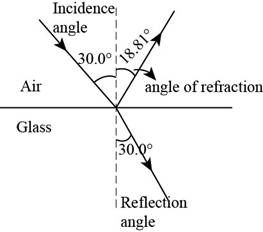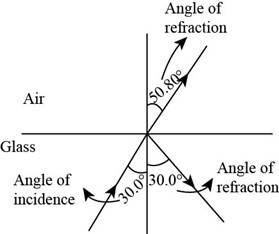
Concept explainers
(a)
The angle of the reflected and refracted rays when light ray incident from the air at angle of incidence
(a)
Answer to Problem 40P
The angle of reflection is
Explanation of Solution
Given info: The index of refraction of glass is
From, law of reflection, the angle of incidence is equal to the angle of reflection.
Thus, angle of reflection is
From Snell’s law,
Here,
Substitute
The figure below shows the angle of incidence, the angle of reflection and the angle of refraction.

Figure (1)
Conclusion:
Therefore, the angle of reflection is
(b)
The angle of the reflected and refracted rays when light ray incident from the glass at angle of incidence
(b)
Answer to Problem 40P
The angle of reflection is
Explanation of Solution
Given info: The index of refraction of glass is
From, law of reflection, angle of incidence is equal to angle of reflection.
Thus, angle of reflection is
From, Snell’s law,
Here,
Substitute
The figure below shows the angle of incidence, the angle of reflection and the angle of refraction.

Figure (2)
Conclusion:
Therefore, the angle of reflection is
(c)
The angles of reflection and refraction for all angles of incidence at
(c)
Answer to Problem 40P
The angle of reflection is same as the angle of incidence and the angle of refraction for rays incident from air onto the air-glass surface is increasing as angle of incidence is increasing. The table for different values of angles is,
| Angle of incidence | Angle of reflection | Angle of refraction |
|
|
|
|
|
|
|
|
|
|
|
|
|
|
|
|
|
|
|
|
|
|
|
|
|
|
|
|
|
|
|
|
|
|
|
|
|
|
|
|
Explanation of Solution
From, law of reflection, the angle of reflection is equal to the angle of incidence. So for all value of angles between
The formula to calculate the angle of refraction is,
From, Snell’s law,
Substitute
Substitute
The remaining values of the angle of refraction can be calculated by the same method.
The table for angle of reflection and angle of refraction for all angles of incidence at
| Angle of incidence | Angle of reflection | Angle of refraction |
|
|
|
|
|
|
|
|
|
|
|
|
|
|
|
|
|
|
|
|
|
|
|
|
|
|
|
|
|
|
|
|
|
|
|
|
|
|
|
|
Conclusion:
Therefore, the angle of reflection is same as the angle of incidence and the of angle of refraction for rays incident from air onto the air-glass surface is increasing as angle of incidence is increasing.
The table for angle of reflection and angle of refraction for all angles of incidence at
| Angle of incidence | Angle of reflection | Angle of refraction |
|
|
|
|
|
|
|
|
|
|
|
|
|
|
|
|
|
|
|
|
|
|
|
|
|
|
|
|
|
|
|
|
|
|
|
|
|
|
|
|
(d)
The angles of reflection and refraction for all angles of incidence at
(d)
Answer to Problem 40P
The angle of reflection is same as the angle of incidence and the of angle of refraction for rays coming up to the interface through the glass will increase up to angle of incidence
The table for angle of reflection and angle of refraction for all angles of incidence at
|
Angle of incidence(
(
|
Angle of reflection(
|
Angle of refraction(
|
|
|
|
|
|
|
|
|
|
|
|
|
|
|
|
|
|
|
|
|
|
|
|
|
|
|
|
|
|
|
|
|
|
|
|
|
|
|
|
|
Explanation of Solution
From, the law of reflection, angle of reflection is equal to the angle of incidence. So, for all value of angles between
The formula to calculate the angle of refraction is,
From, Snell’s law,
Substitute
Substitute
The remaining values of the angle of refraction can be calculated by the same method.
The formula to calculate the critical angle is,
Here,
Substitute
The angle of incidence is greater than
The table for angle of reflection and angle of refraction for all angles of incidence at
|
Angle of incidence(
(
|
Angle of reflection(
|
Angle of refraction(
|
|
|
|
|
|
|
|
|
|
|
|
|
|
|
|
|
|
|
|
|
|
|
|
|
|
|
|
|
|
|
|
|
|
|
|
|
|
|
|
|
Conclusion:
Therefore, the angle of reflection is same as the angle of incidence and the of angle of refraction for rays coming up to the interface through the glass will increase up to angle of incidence
The table for angle of reflection and angle of refraction for all angles of incidence at
|
Angle of incidence(
(
|
Angle of reflection(
|
Angle of refraction(
|
|
|
|
|
|
|
|
|
|
|
|
|
|
|
|
|
|
|
|
|
|
|
|
|
|
|
|
|
|
|
|
|
|
|
|
|
|
|
|
|
Want to see more full solutions like this?
Chapter 25 Solutions
Principles of Physics: A Calculus-Based Text
- Suppose you construct your own capacitor by placing two parallel plates at a distance 0.27 meters apart. The plates each have a surface area of 0.64 square meters. What is the capacitance of this setup? (Give your answer as the number of Farads.)arrow_forwardDraw a diagram with the new arrows. No they do not point all towards the center.arrow_forwardExample In Canada, the Earth has B = 0.5 mŢ, pointing north, 70.0° below the horizontal. a) Find the magnetic force on an oxygen ion (O2) moving due east at 250 m/s b) Compare the |FB| to |FE| due to Earth's fair- weather electric field (150 V/m downward).arrow_forward
- Four charges, qa, qb, qa, and qd are fixed at the corners of a square. A charge q that is free to move located at the exact center of the square. Classify the scenarios described according to the force that would be exerted on the center charge q. Assume in each case that q is a positive charge. Do not assume that the fixed charges have equal magnitudes unless the scenario defines such an equality. qa Яс q %b Force is zero Force is to the left Force is to the right Force is undeterminedarrow_forwardCharge qi = -q is located at position (0, d). Charge q = −2q₁ is located at position (d,0). Charge q3 = located at position (2d, 2d). 5qi is y Determine the net electric field Ĕ net at the origin. Enter your expression using ij unit vector notation in terms of the given quantities, the permittivity of free space €0, and exact rational and irrational numbers. d 9₁ d TH net = 92 d d Xarrow_forwardsolve pleasearrow_forward
- = = R4 R5 = 12.5 Q. A - In the circuit shown, R₁ = R₂ = R 3 voltmeter measures the potential difference across the battery. When the switch is in position 1, the voltmeter measures V₁ = 13.8 V. When the switch is in position 2, the voltmeter measures V2 = 13.4 V. What is the emf ☐ of the battery? 14.93 = What is the battery's internal resistance r? r = V CH Ω R₁₂ V S R₁ 02 2 R₁ 4 R3 R 5arrow_forwardConsider the arrangement of charges shown in the figure. Four charges of equal magnitude Q but varying sign are placed at the corners of a square as indicated. A positive charge q is placed in the center. What is the direction of the net force, if any, on the center charge? Indicate your answer by placing the appropriate label in the first box. Then, suppose that the charge q were to be displaced slightly from the center position. On the figure, label each box with the arrow that best indicates the direction of the net force that would act on q if it were moved to that location. Net Force Answer Bank no force ↑ +2 0 -Q -Q +Qarrow_forwardDon't use ai to answer I will report you answerarrow_forward
- When an electromagnetic wave is reflected at normal incidence on a perfectly conducting surface, the electric fieldvector of the reflected wave at the reflecting surface is the negative of that of the incident wave.a) Explain why this should be so.b) Show that the superposition of the incident and reflected waves results in a standing wave.c) What is the relationship between the magnetic field vector of the incident and reflected waves at the reflectingsurface?arrow_forwardSuppose there are two transformers between your house and the high-voltage transmission line that distributes the power. In addition, assume your house is the only one using electric power. At a substation the primary of a step-down transformer (turns ratio = 1:23) receives the voltage from the high-voltage transmission line. Because of your usage, a current of 51.1 mA exists in the primary of the transformer. The secondary is connected to the primary of another step- down transformer (turns ratio = 1:36) somewhere near your house, perhaps up on a telephone pole. The secondary of this transformer delivers a 240-V emf to your house. How much power is your house using? Remember that the current and voltage given in this problem are rms values.arrow_forwardIn some places, insect "zappers," with their blue lights, are a familiar sight on a summer's night. These devices use a high voltage to electrocute insects. One such device uses an ac voltage of 3970 V, which is obtained from a standard 120-V outlet by means of a transformer. If the primary coil has 27 turns, how many turns are in the secondary coil? hel lp?arrow_forward
 Principles of Physics: A Calculus-Based TextPhysicsISBN:9781133104261Author:Raymond A. Serway, John W. JewettPublisher:Cengage Learning
Principles of Physics: A Calculus-Based TextPhysicsISBN:9781133104261Author:Raymond A. Serway, John W. JewettPublisher:Cengage Learning Physics for Scientists and Engineers: Foundations...PhysicsISBN:9781133939146Author:Katz, Debora M.Publisher:Cengage Learning
Physics for Scientists and Engineers: Foundations...PhysicsISBN:9781133939146Author:Katz, Debora M.Publisher:Cengage Learning An Introduction to Physical SciencePhysicsISBN:9781305079137Author:James Shipman, Jerry D. Wilson, Charles A. Higgins, Omar TorresPublisher:Cengage Learning
An Introduction to Physical SciencePhysicsISBN:9781305079137Author:James Shipman, Jerry D. Wilson, Charles A. Higgins, Omar TorresPublisher:Cengage Learning Physics for Scientists and EngineersPhysicsISBN:9781337553278Author:Raymond A. Serway, John W. JewettPublisher:Cengage Learning
Physics for Scientists and EngineersPhysicsISBN:9781337553278Author:Raymond A. Serway, John W. JewettPublisher:Cengage Learning Physics for Scientists and Engineers with Modern ...PhysicsISBN:9781337553292Author:Raymond A. Serway, John W. JewettPublisher:Cengage Learning
Physics for Scientists and Engineers with Modern ...PhysicsISBN:9781337553292Author:Raymond A. Serway, John W. JewettPublisher:Cengage Learning University Physics Volume 3PhysicsISBN:9781938168185Author:William Moebs, Jeff SannyPublisher:OpenStax
University Physics Volume 3PhysicsISBN:9781938168185Author:William Moebs, Jeff SannyPublisher:OpenStax





